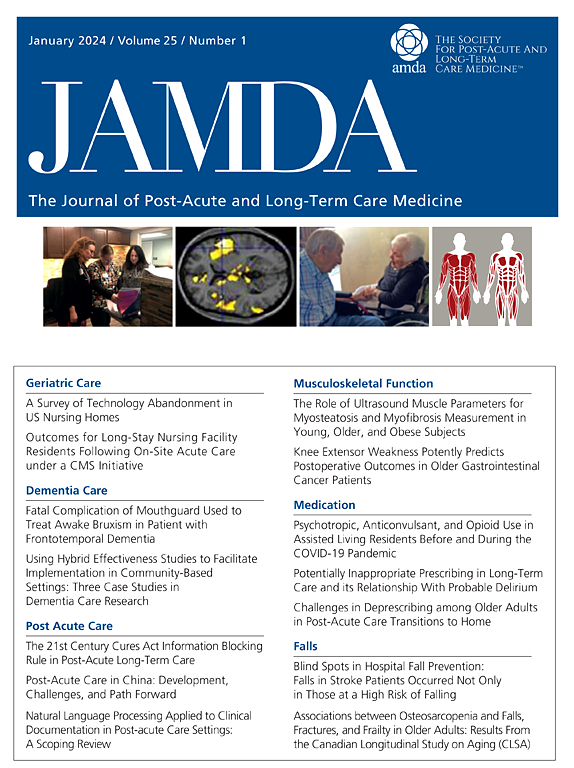IF 4.2
2区 医学
Q2 GERIATRICS & GERONTOLOGY
Journal of the American Medical Directors Association
Pub Date : 2025-03-10
DOI:10.1016/j.jamda.2025.105533
引用次数: 0
摘要
目的:急性心力衰竭(HF)术后护理给管理带来了巨大挑战,尤其是对因阿尔茨海默病及相关痴呆症(AD/ADRD)或严重精神疾病(SMI)导致认知和行为障碍的退伍军人而言。我们假设,并发 AD/ADRD 和 SMI 会降低高频住院后出院回家的可能性。此外,我们还探讨了 AD/ADRD 和 SMI 对退伍军人事务(VA)社区生活中心(CLCs)与医疗保险专业护理机构(SNFs)出院的影响:回顾性队列研究,时间跨度为 2011 年 1 月 1 日至 2019 年 9 月 30 日:退伍军人因急性高血压在退伍军人医院住院治疗(n = 291,117 人):我们研究了退伍军人事务部的高频住院行政数据,以评估AD/ADRD和SMI对出院后地点的影响。利用上一年的诊断代码,我们按照是否存在 AD/ADRD 和/或 SMI 对参与者进行了分层,然后采用逻辑回归模型估算出出院地点的几率比(OR)和 95% 置信区间(CI),并对人口统计学、合并症和医疗保健利用率进行了调整:参与者主要为老年人(平均年龄:78.1 ± 11.1 岁)、男性(97.5%)和自我认同的白人(72.7%)。单纯患有注意力缺失症/注意力缺陷症(n = 16212)或单纯患有严重精神障碍(SMI)(n = 33194)的人数多于同时患有这两种疾病的人数(n = 3612)。与两种情况都不存在相比,单独存在 AD/ADRD(调整 OR [aOR],0.523;95% CI,0.505-0.542)、单独存在 SMI(aOR,0.869;95% CI,0.843-0.896)以及同时存在两种情况(aOR,0.505;95% CI,0.47-0.542)都会降低出院回家的可能性。与SNF相比,患有AD/ADRD和SMI的参与者更有可能出院到CLC(aOR,1.225;95% CI,1.064-1.411):我们的研究结果表明,AD/ADRD 和 SMI 是高血压患者出院回家的主要障碍,这表明在医疗护理过渡期间需要加强监管。本研究呼吁进一步研究出院地点如何影响认知和行为障碍患者的短期和长期临床结果。本文章由计算机程序翻译,如有差异,请以英文原文为准。
Discharge Disposition in Veterans with Heart Failure: Impact of Dementia and Severe Mental Illness
Objectives
Post-acute heart failure (HF) care presents significant management challenges, particularly among veterans with cognitive and behavioral impairments due to Alzheimer disease and related dementias (AD/ADRD) or severe mental illness (SMI). We hypothesized that comorbid AD/ADRD and SMI would reduce the likelihood of discharge home following HF hospitalization. In addition, we explored how AD/ADRD and SMI influence discharge to Veterans Affairs (VA) Community Living Centers (CLCs) compared with Medicare Skilled Nursing Facilities (SNFs).
Design
Retrospective cohort study spanning January 1, 2011, to September 30, 2019.
Setting and Participants
Veterans hospitalized with acute HF at VA hospitals (n = 291,117).
Methods
We examined VA administrative data from HF hospitalizations to assess how AD/ADRD and SMI impact post-hospital discharge location. Using diagnostic codes from the prior year, we stratified participants by the presence of AD/ADRD and/or SMI, then employed logistic regression models to estimate the odds ratios (ORs) and 95% confidence intervals (CIs) for discharge location, adjusted for demographics, comorbidities, and health care utilization.
Results
Participants were predominantly older (mean age: 78.1 ± 11.1 years), male (97.5%), and self-identified as white (72.7%). Those with AD/ADRD alone (n = 16,212) or SMI alone (n = 33,194) outnumbered those with both conditions (n = 3612). Compared with neither condition, the presence of AD/ADRD alone [adjusted OR (aOR), 0.523; 95% CI, 0.505–0.542], SMI alone (aOR, 0.869; 95% CI, 0.843–0.896), and both conditions (aOR, 0.505; 95% CI, 0.47–0.542) all reduced likelihood of discharge home. Participants with AD/ADRD and SMI were more likely to be discharged to a CLC than a SNF (aOR, 1.225; 95% CI, 1.064–1.411).
Conclusions and Implications
Our findings indicate that AD/ADRD and SMI are major barriers to discharge home for patients with HF, suggesting a need for enhanced supervision during health care transitions. This study calls for further research into how discharge location affects short- and long-term clinical outcomes in patients with cognitive and behavioral impairment.
求助全文
通过发布文献求助,成功后即可免费获取论文全文。
去求助
来源期刊
CiteScore
11.10
自引率
6.60%
发文量
472
审稿时长
44 days
期刊介绍:
JAMDA, the official journal of AMDA - The Society for Post-Acute and Long-Term Care Medicine, is a leading peer-reviewed publication that offers practical information and research geared towards healthcare professionals in the post-acute and long-term care fields. It is also a valuable resource for policy-makers, organizational leaders, educators, and advocates.
The journal provides essential information for various healthcare professionals such as medical directors, attending physicians, nurses, consultant pharmacists, geriatric psychiatrists, nurse practitioners, physician assistants, physical and occupational therapists, social workers, and others involved in providing, overseeing, and promoting quality

 求助内容:
求助内容: 应助结果提醒方式:
应助结果提醒方式:


